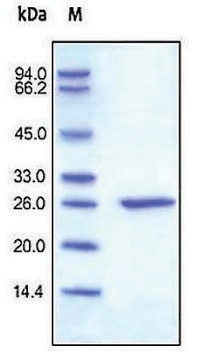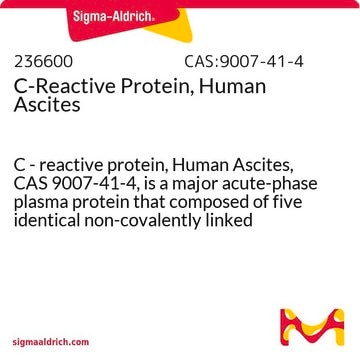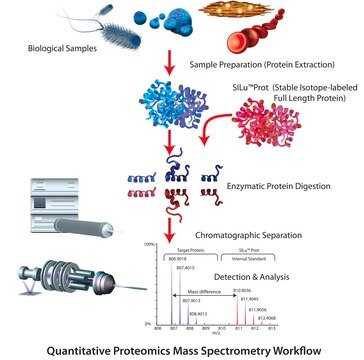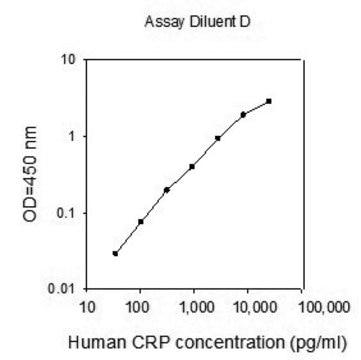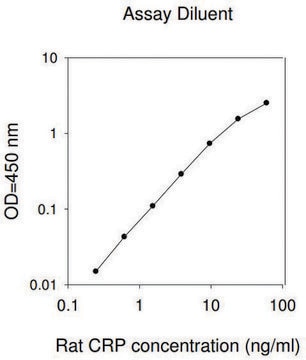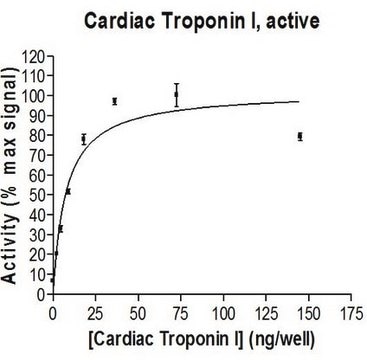Recommended Products
biological source
human
Quality Level
100
300
assay
>98% (SDS-PAGE)
form
liquid
manufacturer/tradename
Chemicon®
concentration
3.5 mg/mL
NCBI accession no.
UniProt accession no.
General description
C-reactive protein (CRP) is a homopentameric acute-phase inflammatory protein, which belongs to the pentraxin family. It is a highly conserved plasma protein produced mainly in liver hepatocytes. It is also synthesized by lymphocytes, smooth muscle cells, macrophages, endothelial cells, and adipocytes.
Application
C-reactive protein (CRP) has been used:
- as a model analyte for interference-reduced detection of CRP in serum using non-competitive sandwich immunoassay in combination with surface plasmon field-enhanced fluorescence spectroscopy (SPFS)
- to determine the involvement of collectin placenta 1 (CL-P1) in CRP-mediated complement activation and to investigate the downstream effects of this complement activation
- to examine to study the effects of lectin-like oxidized low-density lipoprotein receptor 1 (LOX-1) on CRP-induced complement activation by interacting with CRP to develop an inflammatory pathogenic response
Biochem/physiol Actions
C-reactive protein (CRP) plays a vital role in the complement pathway, apoptosis, phagocytosis, nitric oxide (NO) release. It also regulates the production of interleukin-6 and tumor necrosis factor-α. Patients suffering from appendicitis, cholecystitis, pancreatitis, and meningitis have elevated levels of CRP. CRP facilitates the uptake of low-density lipoprotein in macrophages. It has a crucial role in the pathophysiology of cardiovascular disease, which makes it a useful marker for inflammation and cardiovascular events.
Quality
No precipitin bands when tested at 2 mg/mL against anti-whole human serum.
Physical form
Liquid in 100mM NaCl, 10mM Tris-HCl with 0.1% sodium azide, 2mM CaCl2
Storage and Stability
Maintain under sterile conditions at 2-8°C for up to one year. Do not freeze. Full safety precautions should be taken as in the handling of any potentially infective body fluid.
Legal Information
CHEMICON is a registered trademark of Merck KGaA, Darmstadt, Germany
Storage Class
12 - Non Combustible Liquids
wgk_germany
nwg
flash_point_f
Not applicable
flash_point_c
Not applicable
Certificates of Analysis (COA)
Search for Certificates of Analysis (COA) by entering the products Lot/Batch Number. Lot and Batch Numbers can be found on a product’s label following the words ‘Lot’ or ‘Batch’.
Already Own This Product?
Find documentation for the products that you have recently purchased in the Document Library.
Customers Also Viewed
Lectin-like Oxidized LDL Receptor 1 Is Involved in CRP-Mediated Complement Activation.
Fujita Y, Yamaguchi S, Kakino A, Iwamoto S, Yoshimoto R, Sawamura T.
Clinical Chemistry null
Yoshiko Fujita et al.
Clinical chemistry, 56(3), 478-481 (2010-01-16)
C-reactive protein (CRP) increases in response to inflammation and is purported to be a risk factor for atherogenesis. We recently demonstrated that a scavenger receptor, lectin-like oxidized LDL receptor (LOX-1), is a receptor for CRP. In light of the overlapping
Charles R Kiefer et al.
Clinica chimica acta; international journal of clinical chemistry, 413(19-20), 1536-1541 (2012-06-28)
We evaluated the utility of an independent biomarker of early ischemic cellular damage-circulating fractional forms of C-reactive protein (fracCRP), to verify the diagnostic relevance of low Troponin I (TnI) values within the context of a workup for Acute Coronary Syndrome
Nitai Roy et al.
Biochimica et biophysica acta, 1860(6), 1118-1128 (2016-03-01)
C-reactive protein (CRP) is a plasma pentraxin family protein that is massively induced as part of the innate immune response to infection and tissue injury. CRP and other pentraxin proteins can activate a complement pathway through C1q, collectins, or on
Safaa I Khater et al.
Biomedicines, 10(7) (2022-07-28)
Oxidative stress is considered the main etiologic factor involved in inflammatory bowel disease (IBD). Integration of nanocarriers for natural therapeutic agents with antioxidant and anti-inflammatory potential is a novel promising candidate for curing IBD. Herein, the colonic antioxidant and anti-inflammatory
Our team of scientists has experience in all areas of research including Life Science, Material Science, Chemical Synthesis, Chromatography, Analytical and many others.
Contact Technical Service
